RESEARCH
Kato laboratory has mainly studied about the following researches.
01
Development of efficient writing method of magnetic random access memory (MRAM)
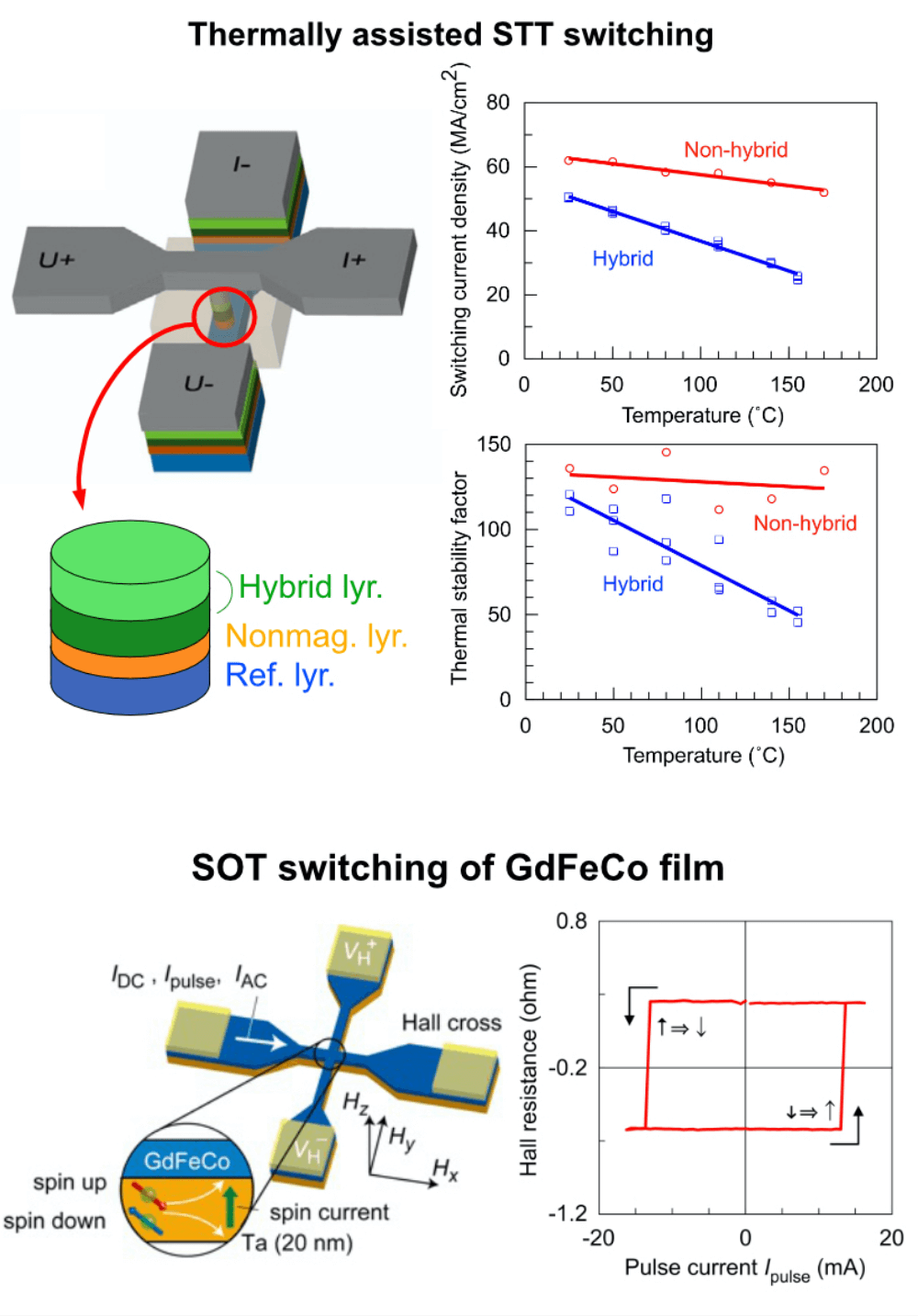
Magnetic random access memory (MRAM) is a non-volatile random access memory that stores data in a magnetic layer, and has extensively studied as a universal memory having features of low power consumption, high density, fast reading/writing speed, and high endurance. The basic structure of MRAM is ferromagnetic (memory) layer / nonmagnetic layer / ferromagnetic (reference) layer, and information is stored as a direction of a magnetization of the memory layer. In order to develop high density MRAM, the development of efficient writing method is crucial. Currently, spin-transfer torque (STT) magnetization switching has been practically used in MRAM, where spin-polarized electrons are injected from the reference layer into the memory layer to switch the magnetization of the memory layer. For further increase of MRAM density, the materials with high perpendicular magnetic anisotropy (PMA) and low STT switching current density are required. However, the STT current density is proportional to PMA, and thus the development of further efficient writing method is an urgent task. In our laboratory, thermally assisted STT magnetization switching has been studied as an efficient writing scheme. The hybrid stack of high and low Curie temperature materials is expected to realize both high thermal stability at room temperature and a low switching current. Our study demonstrated the hybrid memory layer was effective for the practical application for high density MRAM.
Spin orbit torque (SOT) magnetization switching has been also studied for the efficient writing scheme, since SOT switching is known to be ten-times faster and ten-times more energy efficient than STT switching. In our laboratory, rare earth (RE)-transition metal (TM) ferrimagnetic materials in which magnetizations of RE and TM are coupled antiparallelly have been studied, since the net magnetic moment, net angular momentum, and Curie temperature are easily tuned by the composition. Also, they exhibit high PMA which is crucial for the memory layer of high density MRAM. We have reported the low current density in SOT magnetization switching of GdFeCo alloy and the compositional dependence of SOT of GdFeCo. SOT of Gd/FeCo multilayers and Gd/FeCo/Tb multilayers with broken inversion symmetry are also studied.
Electrical field assisted SOT magnetization switching and STT assisted SOT magnetization switching have also been studied for future efficient writing scheme.
02
Spin dynamics probed by ultrashort pulsed laser
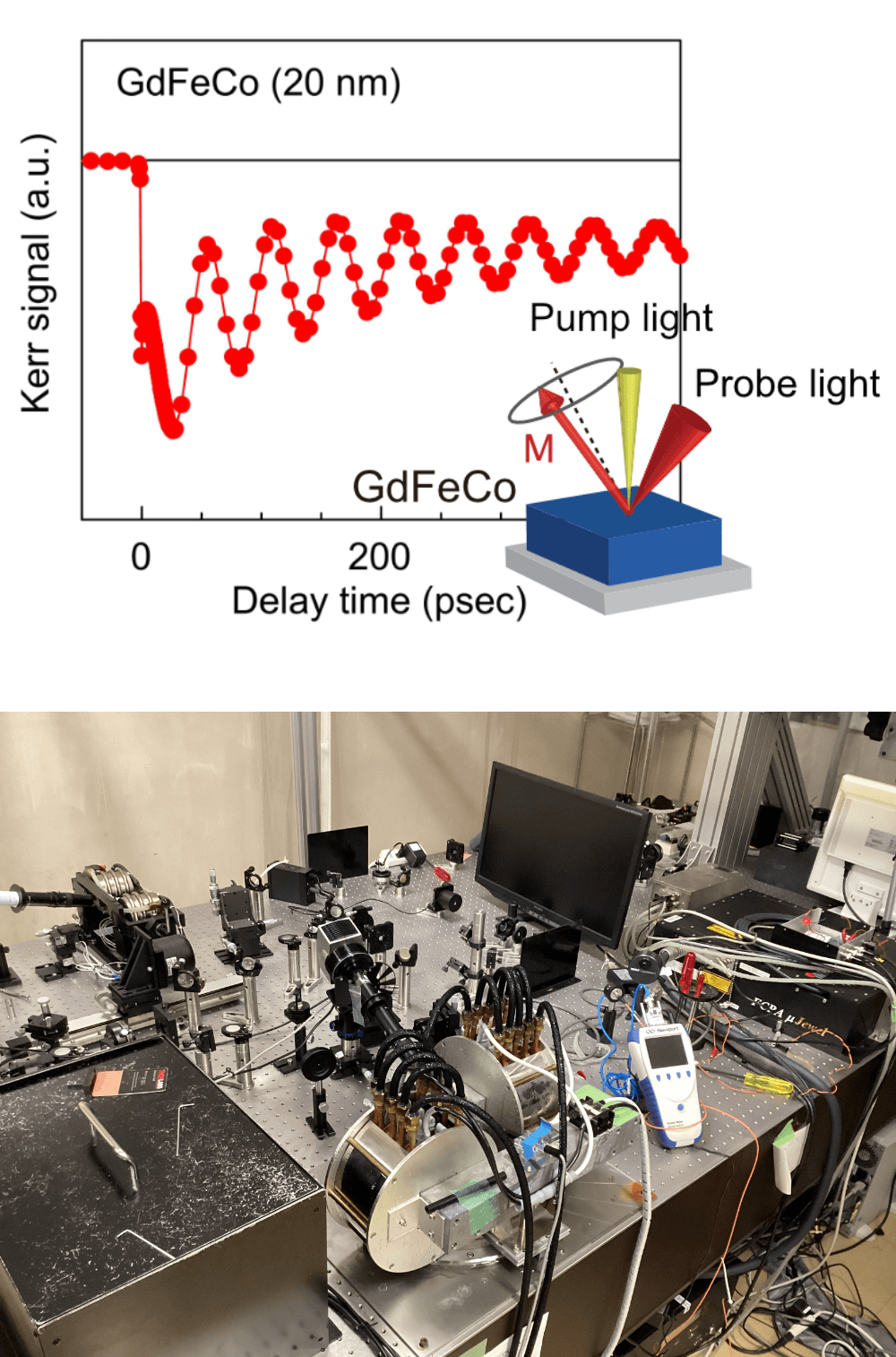
Spin dynamics of the magnetic materials are quite important to realize high-speed magnetic devices, such as magnetic random access memory, magnetic sensor, and inductor. Spin dynamics has been known to follow the phenomenological Landau-Lifshitz-Gilbert (LLG) equation, which is a differential equation predicting the precession of magnetization about the magnetic field and the relaxation of precession due to the phenomenological damping parameter. When the spin current is injected into the magnetic material, additional field-like and anti-damping terms should be included in the traditional LLG equation. The control of the spin dynamics by the spin current is one of the important topic for developing the functional magnetic devices.
Our laboratory designed a pump-probe optical setup using an ultrashort pulsed laser to investigate the time-resolved magneto-optical Kerr effect (TRMOKE) of magnetic materials with a time resolution of 1 psec. Figure shows a typical TRMOKE waveform of a GdFeCo alloy film after the excitation of precession by pump beam illumination. Magnetic parameters, such as gyro-magnetic factor, perpendicular magnetic anisotropy, phenomenological damping constant, can be estimated from this measurement. TRMOKE experiments are useful to develop ultrafast magnetic materials.
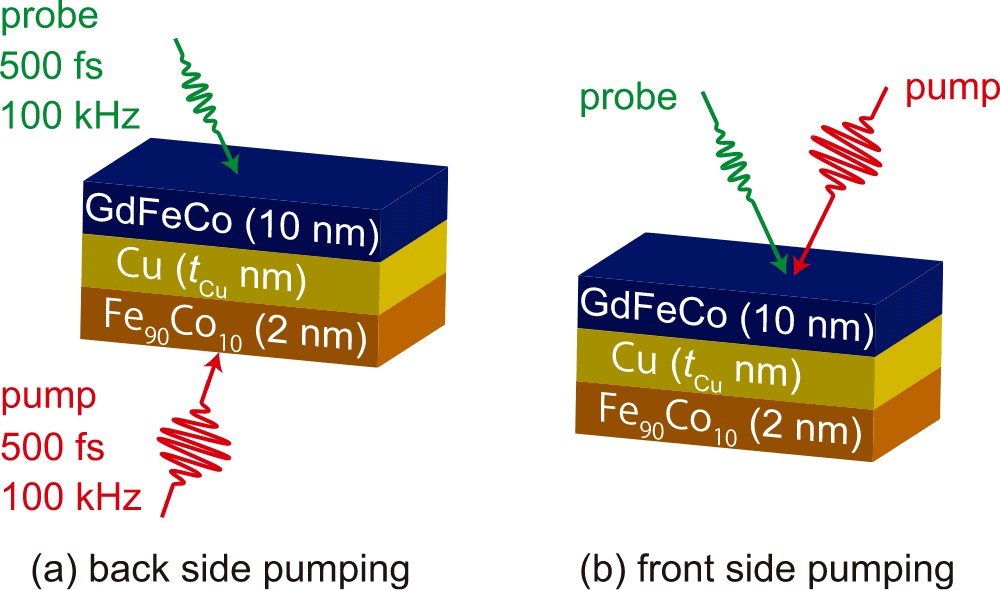
We have also been studying magnetization switching by photo-induced spin current. It is known that spin currents are generated by pumping magnetic materials using an ultrashort pulsed laser, and the photo-induced spin current is useful to understand the spin dynamics under the influence of the spin current. Our laboratory has been investigating the effect of spin currents on the precession motion of GdFeCo/nonmagnetic/FeCo trilayer structure by using the ultrashort pulsed laser.
03
Development of high-performance magneto-resistive sensor
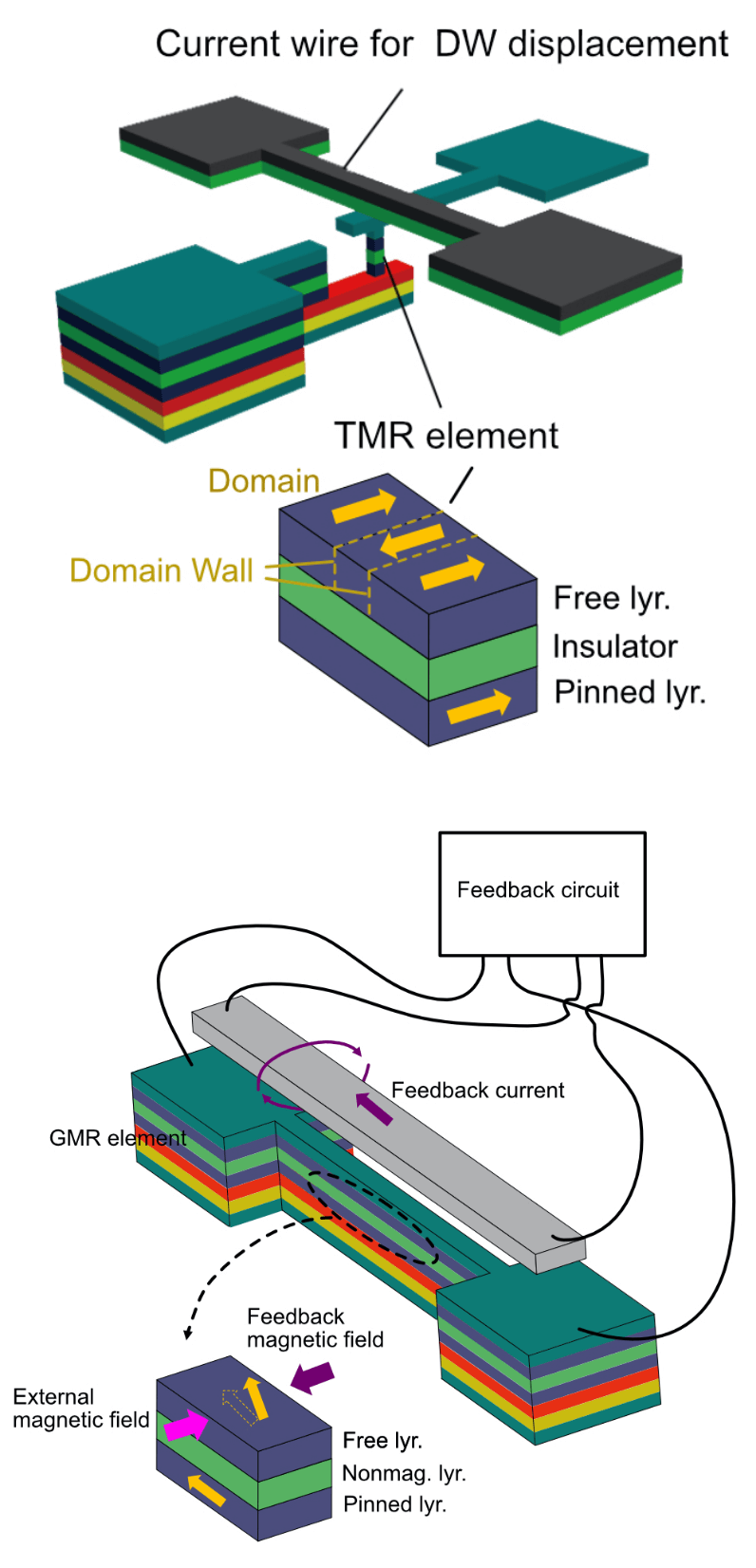
Magneto-resistive sensors have been widely used in many applications, such as read heads of hard disk drive, linear/rotational position sensing devices, and biomagnetic sensors. Compared to other magnetic sensors, magneto-resistive sensor has many advantages, such as high-frequency response over 1 MHz and low price since it is microfabricated using standard lithography process. However, the sensitivity of magneto-resistive sensor is lower than those of SQUID and fluxgate sensors, and the hysteresis of the magnetic layer of the magneto-resistive sensor affects the linearity of the sensor output.
Our laboratory has investigated a new type of magneto-resistive sensor to realize high sensitivity comparable to SQUID sensors as well as high linearity comparable to Hall sensors. Generally, the magneto-resistive sensor consists of a free layer that rotates its magnetization depending on an external magnetic field along the hard axis and a fixed layer that does not react to the external field. On the other hand, we have proposed a domain-wall-displacement-type (DWD-type) magneto-resistive sensor. The sensor detects the external field along the easy axis, and higher susceptibility in the easy axis results in higher sensitivity of the sensor. In order to reduce the effect of the hysteresis in the easy axis, we used the oscillatory domain wall displacement by applying an alternating field along the easy axis. We confirmed the DWD-type sensor detected very small magnetic fields of several nT. We have also proposed a feedback-type magneto-resistive sensor in order to reduce the temperature drift and improve the linearity of the output. In this sensor, the external field along the hard axis is detected by the feedback current which compensates the external field. The feedback-type sensor has the advantages of low temperature drift and a high output linearity. We have fabricated the magneto-resistive sensor on top of which an Al wire is formed for the feedback field by microfabrication technique as shown in the figure. In experiments, as shown in the figure, an Al wire for the feedback magnetic field is formed on top of the magneto-resistive sensor using microfabrication technique, and the sensor operation is investigated by integrating it into an electronic circuit. Currently, the feedback-type sensor detects small magnetic fields of several tens of nT, and higher linearity compared to the conventional sensors. We have been improving the DWD-type sensor and the feedback-type sensor for detecting pT level magnetic field.
04
Fabrication of nano spin structure by ion irradiation and application to magnetic devices
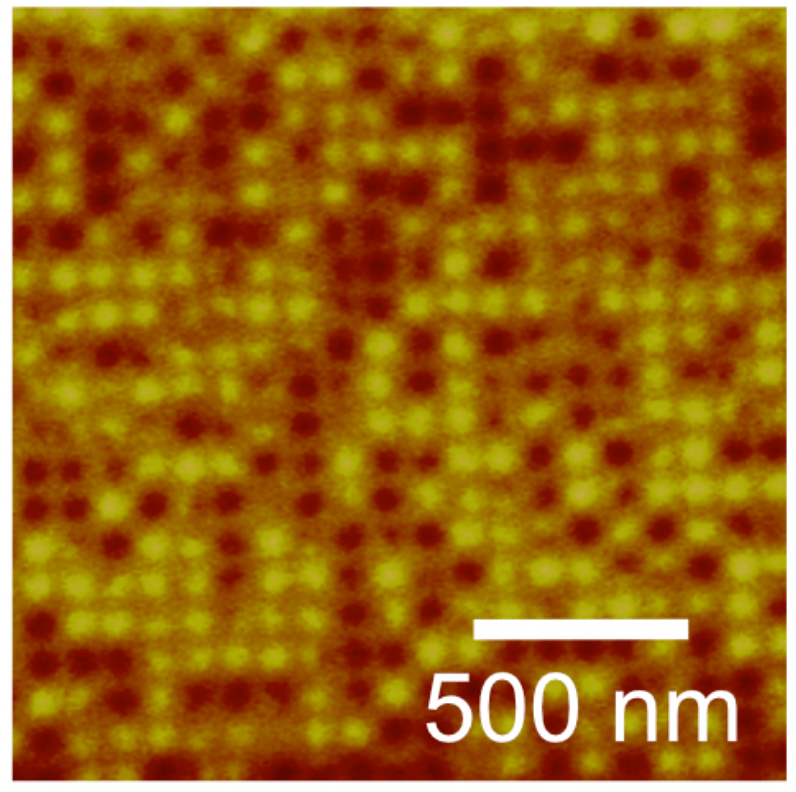
Ion implantation is widely used to locally control the carrier density in semiconductors, and this technique is also useful to locally control the magnetic properties of magnetic thin films. Our laboratory has studied the ion irradiation on the functional magnetic materials, such as Co/Pt multilayer, CrPt3, MnGa, and MnAl. For Co/Pt multilayers, perpendicular magnetic anisotropy (PMA) is locally tuned by the ion irradiation. For CrPt3, MnGa, and MnAl alloy films, the ferromagnetic phase is transferred to nonmagnetic phase by the ion irradiation. Combining with lithography techniques, nano-scale magnetic patterning without etching the magnetic materials is possible.
One application is bit patterned media (BPM), which is regarded as the technology for future ultra-high density hard disk drives (HDDs). The current HDD medium consists of a granular film, in which ferromagnetic granules are segregated in non-magnetic matrix, and one recorded bit consists of several magnetic grains magnetized in the same direction. On the other hand, bit patterned media use lithographically defined bit as shown in the figure, which is effective to postpone the problem of superparamagnetic limit in the conventional granular media. BPM is usually fabricated by etching magnetic material and filling the etched grooves with nonmagnetic material. However, the complicated fabrication process increases the fabrication costs which is crucial for the practical application. Ion irradiation technique is considered to solve the problems due to the simple fabrication process of the bit patterned media with low switching field distribution and flat surface. The figure shows a magnetic force microscope image of ion-irradiated bit patterned media fabricated using CrPt3, in which small bits (50 nm x 50 nm) are separated by nonmagnetic CrPt3. The smooth surface topography is also demonstrated by using the ion irradiation technique.
Currently, we have been applying this technique to fabricate new and functional spintronics devices.